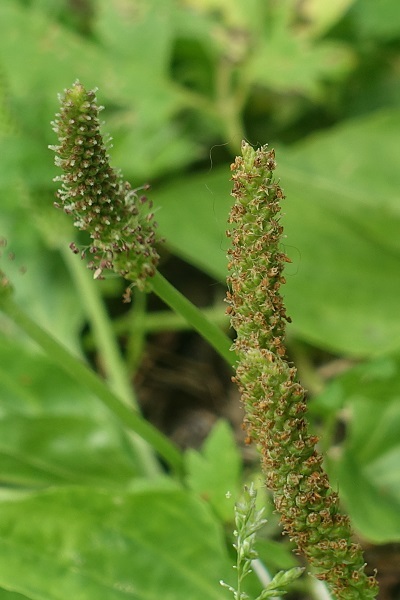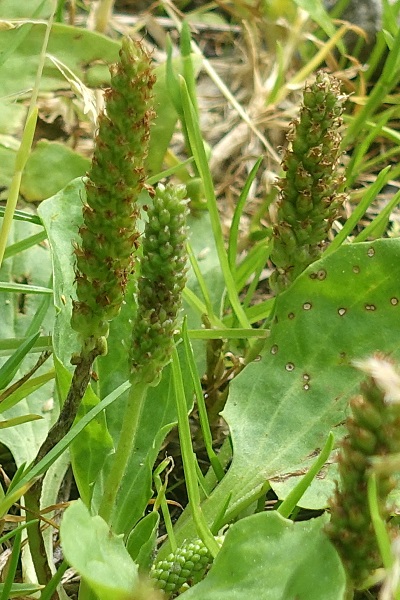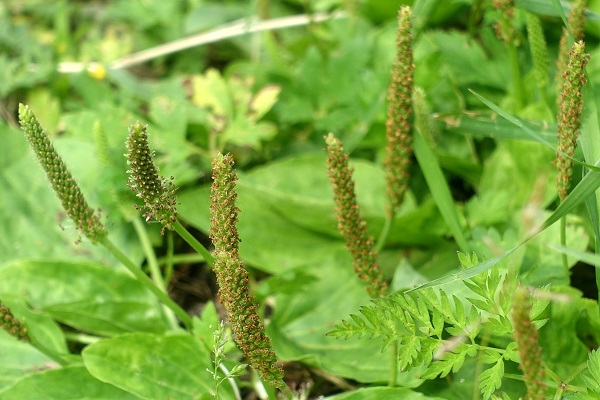Hebrew: לחך גדול, Arabic: لسان الحمل الكبير
| Scientific name: | Plantago major L. | |
| Common name: | Broadleaf plantain, Greater plantain | |
| Hebrew name: | לחך גדול | |
| Arabic name: | لسان الحمل الكبير | |
| Family: | Plantaginaceae, Plantain family, משפחת הלחכיים |

|
| Life form: | Herbaceous perennial | |
| Spinescence: | Non-spinescent | |
| Succulence: | Non-succulent | |
| Stems: | Height 10-50 cm, erect | |
| Leaves: | Rosette; oval-shaped; acute apex, smooth margin; 5-9 conspicuous veins | |
| Inflorescence: | Dense spike 5–15 cm long on top of a stem 13–15 cm tall | |
| Flowers: | Small, greenish-brown flowers; purple stamens | |
| Fruits / pods: | Capsule 2-3 mm long, globose or subconic, glabrous; seeds, very small, oval-shaped, with a bitter taste | |
| Flowering Period: | March, April, May, June, July, August, September, October | |
| Habitat: | Riparian | |
| Distribution: | Mediterranean Woodlands and Shrublands | |
| Chorotype: | Euro-Siberian + Med + Irano-Turanian | |
| Summer shedding: | Ephemeral |

Derivation of the botanical name: Plantago, plantagin (stem), a "plantain". major, comparative of magnus: large, great, high, extensive; larger. The Hebrew name: לחך, lahakh, the plantain, New Hebrew, from לחך, lahakh, was licked up, was lapped up, was eaten up.
Anne Berit Samuelsen (Institute of Pharmacy, Oslo, Norway), outlines the historical use of Plantain as a wound healer in her review article on ethnobotany and phytochemistry of Plantago major (2001). She describes: “The traditional use of P. major in wound healing is quite old. It was described by the Greek physician Dioscorides in ‘De materia medica’ in the first century. The leaves were prescribed for treatment of dog bites (Roca-Garcia, 1972). From the ‘Vølsuga saga’ it is known that the Vikings used P. major leaves for wound healing (Nielsen,1969). P. major was also described in the 12–13thcentury by the Islamic author Ibn El Beithar having adopted the knowledge from Greek medicine (Fleurentin et al., 1983). Henrik Harpestreng († 1244) from Denmark wrote in ‘Liber Harbarum’ that P. major could heal everything that was torn apart. Mixed with honey it was recommended on wounds. Boiled with butter and eaten, it could heal any organ in the human body (Nielsen, 1969).” Leaves of Plantago major were commonly used in the time of Shakespeare and he has mentioned it in his play ‘Romeo and Juliet’, Act I, Scene II from the period 1592–1609: Romeo: Your plantain leaf is excellent for that. Benvoleo: For what, I pray thee? Romeo: For your broken shin Benvoleo: Why, Romeo, art thou mad? Plantago major is thus a well-known medicinal plant in many parts of the world, and it has been claimed that superficial wounds can be healed by application of leaf juice (Brondegaard, 1987). Surprisingly few scientific studies have, however, been performed with the aim to clarify the reason for these wound healing properties. 
*Pictures taken in Ragunda, Sweden (see: www.flowersinsweden.com/Plantagomajor_page.htm). |